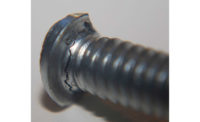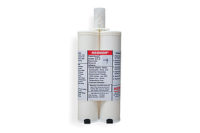The right locking method can keep bolted joints from loosening.
Bolted joints typically fail for one or more of the following reasons: design errors, flawed or damaged fasteners, corrosion, inadequate locking methods, inappropriate preload and incorrect assembly.
Of these, inappropriate preload is the most significant. Preload is the tensile force introduced to the bolt during tightening. This tension force in the bolt creates a corresponding clamping force in the joint. Think of it this way: The clamped parts act like a compression spring; the bolt acts like a tension spring.
The right preload is essential no matter what locking methods are used, particularly in joints that are subject to frequent cyclic loads. Typically, the preload should be 50 percent to 90 percent of the bolt’s yield strength.
The helix angle of a bolt thread—whether metric or standard—is laid out so that the joint is self-locking due to friction in the thread and underneath the head. Producing and maintaining the correct preload in the bolt will ensure this self-locking effect.
There are three basic ways bolted joints become loose:
- Compression of the joint members. Axial forces can trigger loosening of the joint. Neither the screw nor the nut rotates. Preload loss results from settling, or relaxation, of the joint members.
- Rotational loosening of the fasteners. Dynamic shear forces acting on the bolted joint can cause the joint members to slip back and forth. This will prompt screws and nuts to rotate, reducing the preload until it is zero. Simply put, vibration initiates rotational loosening.
- Loss of the fasteners. Under constant dynamic forces, the screws and nuts slack off until they break apart or fall off. Generally, rotational loosening precedes this action.
Compression
Joint compression typically occurs if the joint members are made of a soft material or if they have rough surfaces, thick coatings or thick, hot-dip galvanized layers. And, of course, joints with gaskets are also prone to excessive settling.
If the parts have rough surfaces, this roughness must be reduced or locking elements, such as Belleville washers, split lock washers or wavy washers, must be used to compensate for preload loss. For a washer to work, its spring force must be equal to or slightly higher than the induced preload.
For thick coatings, often the only solution is to remove paint beneath the bearing area of the bolt or nut. If the joint members or fasteners are galvanized, the use of stainless steel fasteners can minimize settling. Stainless steel fasteners are not galvanized, so less settling occurs.
Ironically, extending the clamping distance, such as with an extension sleeve, can reduce the impact of settling. The same amount of joint settling on a longer bolt results in less preload loss.
If the joint member is made of a soft material, consider switching to a new, harder material or increase the bearing area of the bolt or nut. Another possibility is to use a large, hard washer. In any event, it will be necessary to test whether increased diameter or hardness in the bearing area is sufficient to deal with the induced surface pressure.
If a gasket is used, the gasket should be recessed, so that metal to metal contact can be maintained.
Rotational Loosening
In a well-designed bolted joint at rest, the self-locking effect is maintained, and no rotational loosening will take place.
Rotational loosening is triggered by vibration. The vibrations that cause the most rotational loosening are those that act perpendicular to the bolt axis. In other words, transverse cyclic loads cause reciprocal slips in the interfaces of the joint members.
The bolt head and the nut follow the sliding of the joint members. If the bolted joint has a short clamping range, the sliding of the joint members will induce wobbling, or oscillations, underneath the head and nut and in the engaged threads. This causes microslippage in the thread and underneath the head or the bearing area of the nut. A gradual rotational loosening will result.
Preventing rotational loosening is a complex issue, but there are ways to do so or at least minimize it.
A simple way to maintain the self-locking effect is to increase the clamping distance. Because the bolt shank is longer, the bolt head and the nut can follow the sliding of the joint members without causing wobbling and sliding in the critical areas. A clamping distance of five times the bolt’s diameter usually solves the problem. Depending on the intensity of the vibration, the clamping range can be shorter, but to be on the safe side, engineers should use five times the diameter.
Obviously, there are times when increasing the clamping range is impossible. In this case, there are two ways to prevent rotational loosening. One is to prevent wobbling. The other is to keep the fasteners from rotating.
To prevent wobbling, we must eliminate thread play. This can be accomplished either by using a locking adhesive or by using thread-forming screws.
A locking adhesive fills up all the empty spaces, which eliminates thread play and, consequently, wobbling. As a result, friction is maintained in the thread, and rotational loosening is prevented.
Thread-forming screws produce their own "play-free" mating threads. Because there are no gaps between the threads and the joint members, there’s no place for the fastener to move during vibration.
Another way to prevent fasteners from rotating is to increase the friction in the bearing area of the bolt or nut by using toothed, serrated or ribbed locking elements. For effective locking, the locking teeth must be able to dig into the clamped material and the bearing areas of both the bolt and nut. If the teeth do not interlock on all parts, rotational loosening cannot be prevented.
This means that lock washers, such as split lock washers, toothed lock washers, and serrated lock washers, are only effective up to property class 6.8, which is slightly higher than grade 2. Similarly, ribbed washers are only effective up to property class 10.9, or grade 8, depending on how they are configured. Serrated screws are effective up to the equivalent of property class 10.9.
Complete Unwinding
This is the worst-case scenario. Forunately, in most cases, the joints are retightened before they fall apart. The problem, however, is that if the parts are loose, assembled parts may shift. In many applications, a certain amount of joint looseness does not impair the usability of the product. In other cases, it’s disastrous.
To prevent complete unwinding of nuts and bolts, the friction in the thread must be increased. It is important to note that a certain amount of joint loosening cannot be prevented. Generally, 20 percent to 30 percent of preload can be maintained in any joint. The preload loss may be less if the amount of vibration is less.
One way to increase thread friction is to use prevailing-torque fasteners, such as all-metal lock nuts, nylon-patched fasteners, and lock nuts with nylon inserts. Again, there are limitations. Prevailing-torque fasteners are effective up to property class 8.8, or grade 5. This is not to say that they do not work on class 10.9, but the break-loose torque on higher property classes is higher compared with the frictional resistance of a given prevailing-torque feature. If in doubt, test them in the application.
At times, bolted joints may be subjected to all three types of loosening. Therefore, more than one locking feature must be used to ensure that the joint stays tight. For example, if there is excessive joint settling and rotational loosening, choose two locking methods—one that prevents settling and another that prevents rotational loosening.
Joint loosening has long been a problem, but it can be eliminated or delayed until the end of the useful life of the equipment. Engineers must examine the causes of joint failure and take appropriate action. However, it may take some time to resolve the problem. Fastener experts and end users must find a solution to the problem—together.


